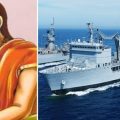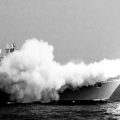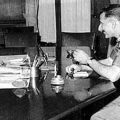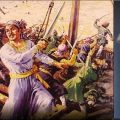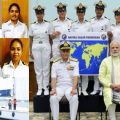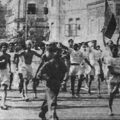1971 Indo-Pak Naval Battle; Why Shivaji Hailed as Father of Indian Navy?
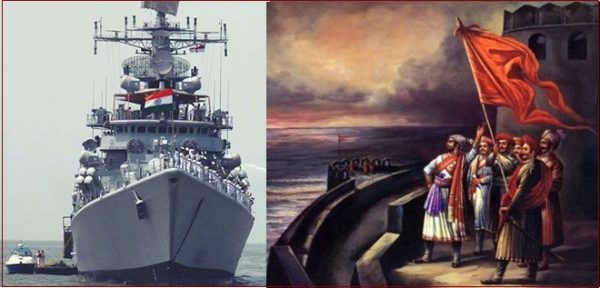
4th December. It is Indian Navy Day. On this day, India salutes the bravery, role, and achievements of Indian naval forces, especially their contribution in the Indo-Pak War of 1971. Indian Navy played an instrumental role in India’s victory in the war.
Here’s a short glimpse, a flashback of the victory of the 1971 naval battle. It was the night of 4th December 1971. Operation Trident was ready for action under the commandment of Vice Admiral S.N. Kohli in the western naval base. And they attacked the port of Karachi with missile boats. PNS Khyber, Pakistani destroyer and PNS Muhafiz minesweeper sank in the attack. The Pakistan Navy reciprocated with their submarines hunting out for Indian warships, but in vain.
Operation Trident continued operations on the night of December 5. Pakistan’s PNS Shah Jahan was shoddily damaged. This paralyzed the enemy’s participation as they lost reserve fuel including numerous commercial ships. With Operation Python joining on the night of 8th and 9th December, Karachi port is further damaged. Use of missile boats resulted in submerging of three more Pakistani merchant ships and damage of their reserve fuel tanks.
The eastern forces of the Indian Navy under the commandment of Vice Admiral Krishnan trapped the Eastern Pakistan Navy by blocking the naval route in the Bay of Bengal. This resulted in complete isolation of East Pakistan. The Indian naval forces fenced in eight foreign merchant ships in the eastern ports.
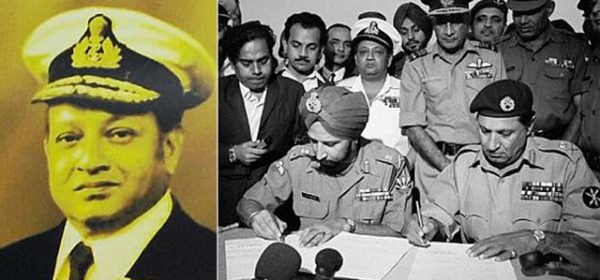
Vice Admiral Krishnan (PC: indiatimes.com)
Meanwhile from 4th December, Sea Hawk fighter-bombers from INS Vikrant aircraft carrier laid attack on numerous coastal towns in East Pakistan. Pakistan reciprocated, deploying submarine PNS Ghazi towards Vishakapatnam, but it sank en route. Unfortunately, on 9th December, Pakistan laid a successful attack with its submarine PNS Hangor, resulting in sinking of India’s INS Khukri frigate in the Arabian Sea. 194 Indian Navy personnel including 18 officers lost their lives under water.
In war with the Indian naval forces, Pakistan lost half of its navy. The Karachi port was badly destroyed. Indian Navy captured three of their big merchant navy ships and 10 smaller ships. Around 1900 Pakistani naval personnel lost their lives and 1413 captured. 18 of Pakistan’s cargo and related vessels in addition to 2 destroyers, 3 patrol crafts, 7 gunboats, 1 minesweeper, and 1 submarine were destroyed. Eventually, India won the war against Pakistan.
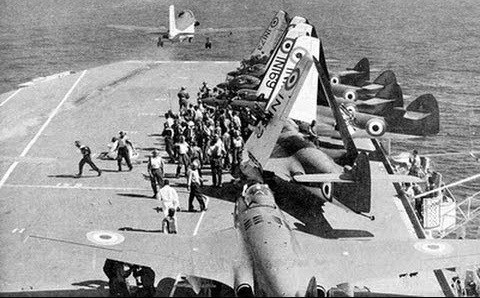
Indian Navy Operations in Eastern Front during Indo-Pakistani War of 1971; Source: YouTube
On the occasion of Indian Navy Day, Maj Gen GD Bakshi wrote on his Facebook timeline, “Today is Navy Day- the day our missile boats launched a most daring attack on Karachi Harbor sank six ships in their very home base and set the Karachi oil tanks on Fire so they burnt for a week. No other navy has ever pulled off such a daring attack on the very home base of the enemy Navy and gotten away unscathed. Who dares wins.”
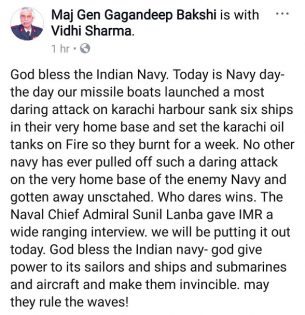
During the 17th century, the strong Maratha Navy under the kingship of Chhatrapati Shivaji, defended the Indian waters against numerous foreign forces. The Maharaja’s naval force was well trained and their ships were mounted with cannons, always ready for action. Shivaji erected watch posts on the Andaman Islands, which helped him keep a watch on foreign ships. His naval forces attacked English, Dutch and Portuguese ships and captured British vessels. It was Shivaji who created several naval bases and stationed a strong professional naval force in the Indian waters. Hence, he is also known as the ‘Father of Indian Navy’.
One of the strong existing naval bases constructed by Shivaji Maharaj is the Sindhudurg Fort, located in an islet called Khurte bet in the Arabian Sea on the shore of Malvan town, off the west coast in Konkan region of Maharashtra. The fort, spread over 48 acres, was constructed in 1664 under the supervision of Hirojee Indulkar. It took three years to build it. The strength of the fort is well corroborated by the strong walls that have survived attacks, waves and tides of the Arabian Sea, and the ravages of time. Over 4000 pounds of lead were used in the casting during construction and foundation stones were firmly laid down. While the rampart is 3 km long, the walls are 30 feet in height and 12 feet in thickness. Shivaji was not only powerful on land but also equally powerful in the sea. The robust Sindhudurg Fort helped Shivaji counter the rising influence of the Siddis of Janjira, Dutch, British, French, and Portuguese.
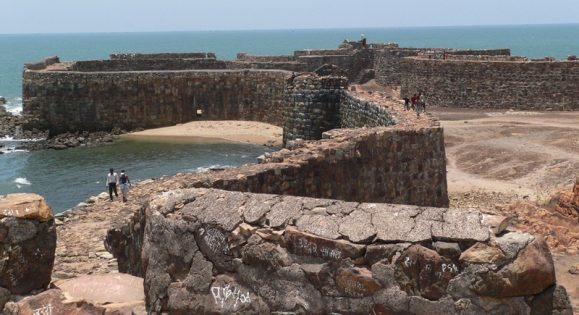
Sindhudurg Fort west wall; Image source: Wikipedia
Few Maratha naval commanders worth mentioning are Mainak Bhandari, SidhoJi Gurjar, Kanhoji Angre, and Mendhaji Bhatkar who plundered Portugese and British ships, killing thousands of the enemy sailors. Such was the robustness of the Maratha naval forces and ships in the India waters that Shivaji, who started the robust bases, came to be known as the Janak, i.e. the ‘Father of Indian Navy’.
Maynak Bhandari, Sidhoji Gurjar, and Daria Sarang were three of the ablest Admirals of the Maratha Navy under Shivaji Maharaj. Under their leadership, the Marathas could not only safeguard the coastline from enemy forces but also won several naval battles. Under the commandment of Maynak Bhandari, who commanded a naval fleet of 200 ships, the Marathas took possession of Khanderi fort (located in an island, south of Mumbai) from the British. From the Khanderi Fort site, the Marathas involved in several naval battles against the Siddis of Janjira.
Maratha Navy soldiers consisted of native Konkani soldiers and mercenaries. The Portugese were powerful at sea. Shivaji deployed effective strategies to steal the Portugese technology and capabilities so that the same could be implemented while designing Maratha warships as well as to control the waters at Sea. Hence, he hired few Portugese, who were loyal to the Marathas. One Portugese naval officer worth mentioning is Rui Leitao Viegas, who was the Maratha fleet commander.
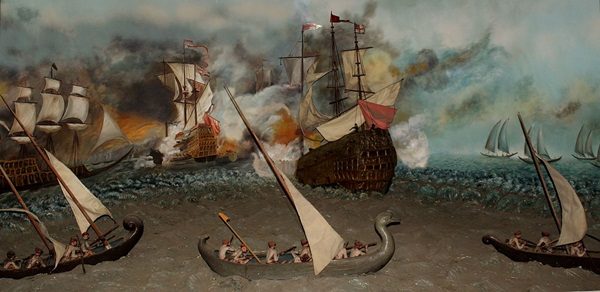
A diorama showing Maratha naval tactics, on display at the National Museum, New Delhi; Source: Wikipedia
According to Maratha chronicles, Shivaji’s naval fleet had around 700 vessels of various sizes capacities that included ships, warships, small and large row boats, gun boats, canoe, cargo boats, large vessels with two masts, and the list goes on.
Later, Maratha naval admiral Kanhoji Angre was involved in naval battles with the British, Dutch and Portuguese in the Indian waters many times. For more than four decades, he guarded the western coast of India and became a terror to European powers at sea. He always led his sailors to victory. He never faced defeat. He emerged as a master of the Indian waters from Surat to south Konkan. He elevated the naval prestige of Maharashtra in particular and India in general in the Indian waters during a period when the Mughals, British, Portugese, and Dutch held power. He remained victorious until his death!
Historical records corroborate the stationing of naval forces by the Mauryas, Guptas, Palas, Cholas, Satvahanas, Vijayanagara, and more in the Indian waters. Chandragupta Maurya’s Prime Minister Kautilya (Chanakya) in his book Arthashastra had written about ocean waterways. According to an article published at indiannavy.nic.in, “Chandragupta Maurya established an Admiralty Division under a Superintendent of Ships as part of his war office, with a charter including responsibility for navigation on the seas, oceans, lakes and rivers.”
Vijaya of Bengal defeated the Ceylonese and established his kingdom in Ceylon. The Pala Navy kept strong guard in the coastal areas along the Bay of Bengal. Chandraketugarh, which was part of the Gangaridai kingdom, (presently called Kolkata) was a port city. Gangaridai finds mention in accounts by Ptolemy, a Greco Roman geographer, astronomer, and mathematician from the second century CE.
In the northeastern and eastern parts of India, there have been several instances of river naval battles won by local rulers against foreign forces. It was a strong river naval base along the Brahmaputra that led Ahom commander Lachit Borphukan of Assam decimate the Mughal forces in 1671 in the Battle of Saraighat. Before this another naval battle was fought in Assam between the Ahoms and the Bengal Sultanate in 1533. It was the battle of Duimunisila. Tonkham Borpatra Gohain, the Ahom general, badly defeated the Afghan forces killing the Islamic commander Turbak Khan. The battle took place at Duimunisila along the banks of the mighty Bharali River. Rudranarayan of Bhurishrestha Bengal from the 16th century stationed a strong naval force along the Damodar and the Ron river banks of his territory.
In the south, the Chola Navy had a robust naval base in the Indian waters. They led naval expeditions between 900 to 1100 AD. Few successful naval expeditions include conquest of Indonesia (then known as Sri Vijaya) and Ceylon islands. It was under Rajaraja Chola I and his son Rajendra Chola I, that the Chola dynasty expanded their territories with a robust military and naval base. Raja Marthanda Varma of Travancore was one of the first Asian kings to badly defeat a robust Dutch army in a naval battle at Colachel in 1741.
The history of Indian maritime dates back to thousands of years, as early as the pre-Rigved period. The Rigved finds mention of Varun, the God of water and the celestial ocean, as having knowledge of sea routes. Sanskrit terminologies like Navadhyaksha, Nava Dvipantaragamanam, Samudrasamyanam, Matsya Yantra, etc. that find mention in ancient manuscripts refer to the existence of sea routes, ships, exploration, sea warfare, navigation, and sea trade in ancient times. Excavations at Lothal in coastal Gujarat in present Mangrol harbour substantiate the historicity of the port area dating back to 2300 BC corresponding to the Indus Valley Civilization.
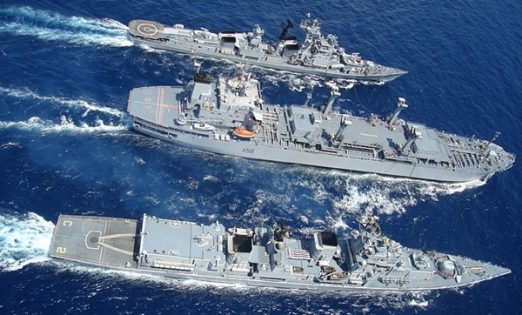
From top to bottom: INS Ranjit, INS Jyoti and INS Mysore; Source: Wikipedia
Do you know most of the Indian naval warships are of indigenous design? These warships, built in Indian shipyards, are at par with international counterparts and those constructed by advanced countries. Indian Navy inventory is equipped with sophisticated submarines, advanced missile-capable warships, latest aircraft, minesweepers, and aircraft carriers. The fifth largest naval force in the world, Indian Navy has two major naval bases in Mumbai and Visakhapatnam.
Featured image courtesy: deewaneaam.com and Pinterest.

